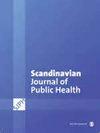严格的丹麦人还是放松的瑞典人?比较瑞典和丹麦在 Covid-19 大流行期间的健康状况和日常活动
IF 2.6
3区 医学
Q2 PUBLIC, ENVIRONMENTAL & OCCUPATIONAL HEALTH
引用次数: 0
摘要
目的:尽管丹麦和瑞典在文化上有许多相似之处,但在 2020 年爆发的 Covid-19 病毒疫情中,两国采取了截然不同的策略。丹麦迅速实施了严格的政府限制措施,而瑞典则倾向于采取更加渐进和自愿的方式。本研究旨在分析Covid-19疫情爆发后两国在心理健康指标(抑郁症状、睡眠问题和孤独感)、日常活动(购物、散步、探亲和与他人会面)和医疗护理方面的差异。方法:本研究利用了欧洲健康、老龄化和退休调查(SHARE)第8波(2019/2020年)和两次SHARE Covid-19调查(2020/2021年夏季)中的50岁成人数据。多层次逻辑回归模型评估了瑞典和丹麦的纵向和横截面变化。结果:2020年夏季,两国抑郁症状和睡眠问题的风险都有所下降,但丹麦的抑郁症状下降更为显著:17.8%(95% 置信区间 (CI) 15.0-20.6)对 12.5%(95% 置信区间 9.0-15.9)。瑞典受访者更有可能在 2020 年夏季减少日常活动(购物:几率比 (OR)=0.45,95% CI 0.36-0.55;探亲:结论:大流行期间,瑞典和丹麦在心理健康和日常活动方面的差异很小。尽管斯堪的纳维亚人的日常生活受到了严重破坏,但他们 50 岁以上的人却表现出了非凡的适应能力。本文章由计算机程序翻译,如有差异,请以英文原文为准。
Strict Danes or relaxed Swedes? Comparing health and daily activities in Sweden and Denmark during the Covid-19 pandemic
Aims:Amidst the Covid-19 outbreak in 2020, Denmark and Sweden adopted contrasting strategies despite their many cultural similarities. Denmark swiftly imposed strict governmental restrictions, while Sweden favoured a more gradual, voluntary approach. This study aims to analyse the disparities between the two nations in mental health indicators (depressive symptoms, sleep problems and loneliness), daily activities (shopping, going for a walk, visiting family and meeting other people) and medical care after the Covid-19 outbreak.Methods:Data from adults aged ⩾50 years in the Survey of Health, Ageing and Retirement in Europe (SHARE) wave 8 (2019/2020) and the two SHARE Covid-19 surveys (summer 2020/2021) were utilised. Multilevel logistic regression models assessed longitudinal and cross-sectional changes in Sweden and Denmark.Results:Both countries witnessed reduced risk of depressive symptoms and sleep problems during summer 2020, albeit with a more significant decline in depressive symptoms observed in Denmark: 17.8% (95% confidence interval (CI) 15.0–20.6) vs. 12.5% (95% CI 9.0–15.9). Swedish respondents were more likely to reduce their daily activities in the summer of 2020 (shopping: odds ratio (OR)=0.45, 95% CI 0.36–0.55; visit family: OR=0.76, 95% CI 0.60–0.97) and less likely to have medical appointments postponed (OR=1.83, 95% CI 1.46–2.28).Conclusions:Minimal differences were observed between Sweden and Denmark in mental health and daily activities during the pandemic. Despite significant disruption to their daily routines, Scandinavians aged ⩾50 years old demonstrate remarkable resilience.
求助全文
通过发布文献求助,成功后即可免费获取论文全文。
去求助
来源期刊

Scandinavian Journal of Public Health
医学-公共卫生、环境卫生与职业卫生
CiteScore
6.50
自引率
2.90%
发文量
135
审稿时长
4-8 weeks
期刊介绍:
The Scandinavian Journal of Public Health is an international peer-reviewed journal which has a vision to: publish public health research of good quality; contribute to the conceptual and methodological development of public health; contribute to global health issues; contribute to news and overviews of public health developments and health policy developments in the Nordic countries; reflect the multidisciplinarity of public health.
 求助内容:
求助内容: 应助结果提醒方式:
应助结果提醒方式:


